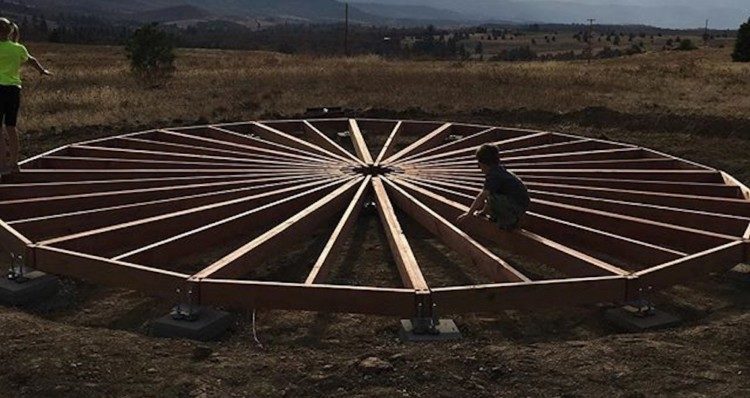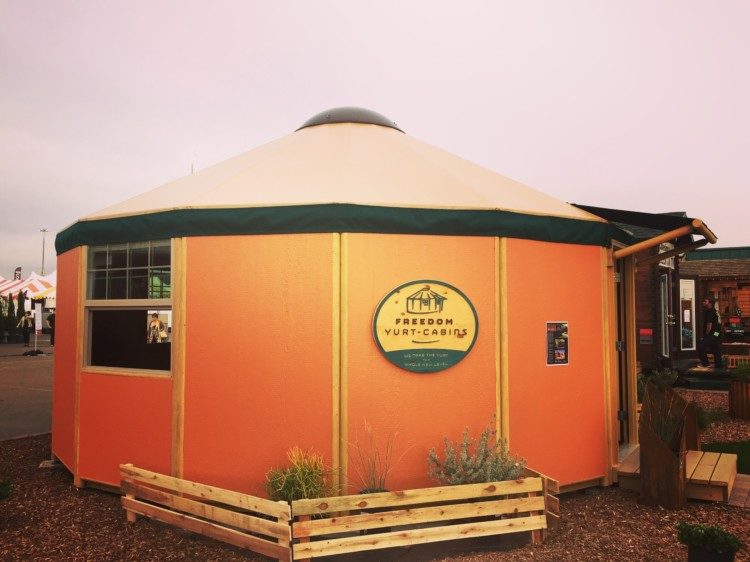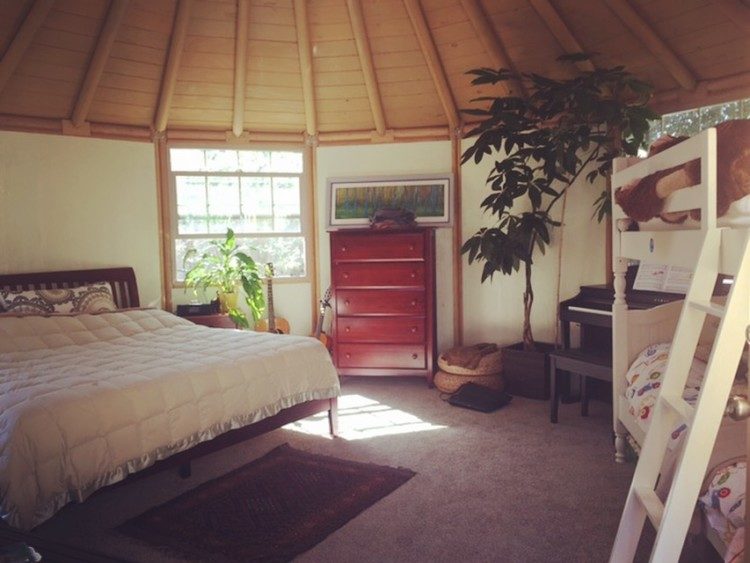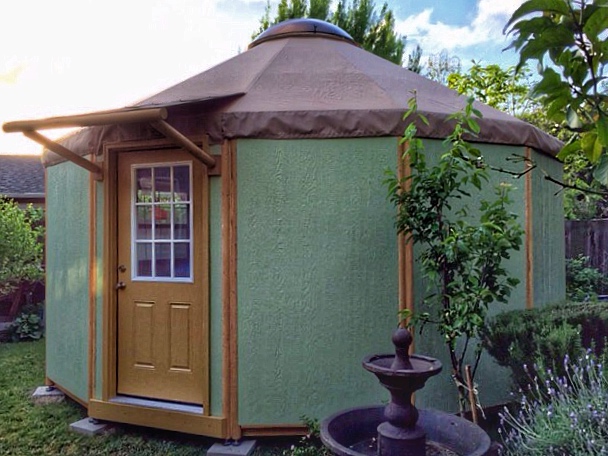Guest Post by Josh Barry
The technology for outdoor living has come a long way since nomadic Mongolians first created Gers, commonly referred to today as Yurts. In fact, the first instance of Yurts in recorded history dates back to hundreds of years before the birth of Jesus! Yurts were the perfect way for nomadic peoples to be able to quickly construct temporary shelters which were capable of retaining heat from a small fire or stove. When a tribe decided to move, their Yurts could be taken down and packed for transport in minutes. Generally, these structures consisted of a circular frame of wooden lattice, rafters, a roof ring, and a tension band which kept the walls and roof from expanding. In the 1960’s, a gentleman named William Coperthwaite pioneered a new design of Yurts that have been very common in North America for nearly half a decade. In 1978, Oregon-based Pacific Yurts became the first company to manufacture Yurts using architectural fabrics and structural engineering. Since then, a multitude of companies have manufactured similar Yurt structures both in North America and around the world. While modern Yurts do incorporate engineered fabrics, steel tension cables, and robust rafters for use in snowy environments, their basic design has not departed very far from the Gers of ancient Mongolia. \However, when my father, Richard Barry, debuted the innovative Freedom Yurt Cabin in 2014, many Yurt and Tiny House enthusiasts began to see how an updated Yurt structure could play a crucial role in modernized, sustainable housing.
The Floor System
Early Gers and Yurts were usually erected on flat ground in the vast plains of Northeast Asia. 20th century North American Yurts are generally built on a solid deck or platform which serves as the floor for the structure. The problem with common Yurt decks is that they eliminate the portable, temporary nature of the Yurt which is one of the structure’s most defining features. Not only is a permanent deck impractical to relocate, but it often doubles the price of a Yurt project. When Richard Barry set out to design a modern, hard sided Yurt structure, he started from the foundation and made it his goal to merge the portable, temporary nature of Mongolian Yurts with the structurally sound components of a permanent Yurt platform. The result:

Not only is the deck on a Freedom Yurt Cabin strong and portable, but it is integrated into the structure. It is made up of treated 2×6 and double 2×6 joists which radiate outward from a steel center ring. Both the joists and center ring are supported by adjustable “feet” which rest on concrete pads or pavers. The deck is then fastened to Duckbill Earth Anchors which are driven into the ground at an angle and fastened with turnbuckles to steel plates on each sub-floor joist. When fully assembled, this allows the Yurt Cabin to accomplish a 120 mph wind rating while still maintaining portability. If a Yurt Cabin owner wishes to relocate their structure, it can be disassembled and packed away in less than a day. Unlike a permanent deck which may take days to complete, the platform of a Yurt Cabin can be assembled in hours which saves plenty of time and headache!
Walls, Windows, and Doors
One gripe that we often hear from Yurt owners is that their roll-up plastic windows (which generally must be opened from outside the structure) don’t really give the appearance or feel of a solid structure. Rather, they often make Yurts seem more akin to large tents. Freedom Yurt Cabins come standard with solid walls and high quality, double pane, low-e windows which even include screens! The walls of a Yurt Cabin are made from a sturdy roundwood frame with two inches of R-9.7 rated insulation between structural siding panels on the inside and outside. Not only do they allow a Yurt structure to achieve insulation ratings not possible in a fabric Yurt, but their thermal mass is significantly higher than the lattice and fabric of a Yurt-tent for greater heat retention in winter months. Don’t fall for the phony claims of space-age insulation from Yurt-tent manufacturers! When it comes down to it, R-value per inch is the standard by which insulation is measured and it is impossible for the thin metal foil in a fabric Yurt to retain heat the way structural siding and R-9.7 insulation can in the walls of the Freedom Yurt Cabin. The roundwood frame of each wall is finished with a high quality log cabin stain and each panel is painted to order inside and out. Because the Yurt Cabin utilizes materials which are readily used in stick-frame building, these walls are much more resistant to humidity and fungal decay than the fabric of a Yurt-tent and will last a lifetime if maintained properly!

Roof, Ceiling, and Dome
When it comes to the overhead components in the Yurt Cabin, the structure distinguishes itself again and again over fabric Yurts. To start, the Yurt Cabin’s tongue and groove style ceiling is completely unique in the industry. It is accentuated by the beautiful Lodgepole Pine rafters which not only allow the Yurt Cabin to meet snow load requirements anywhere in the continental United States, but also create a true log-cabin feel inside of the structure. Above the ceiling is two inches of R-13.7 foam insulation with reflective backing on the inside and out. This insulation features the highest R-value per inch of any insulation that is commercially available in the United States and far exceeds the insulating capability of Yurt-tents. As heat naturally rises within the structure, this robust roof insulation is key to keeping the Yurt Cabin warm in chilly winter months.
While some Yurt-tents come standard with fabric roofs that carry short warranties, Freedom Yurt Cabins always include Duro-Last commercial grade roofs which are warrantied for 15 years. Duro-Last has proven itself for decades, and in fact, over 2 billion square feet of Duro-Last has been installed as commercial grade roofing in North America. Duro-Last is a reinforced vinyl roofing membrane which is known for its durability in the face of heavy UV rays. Many Yurt customers claim that Duro-Last can last for several decades while still maintaining its color and structural integrity!
The Yurt Cabin is topped off by an industry standard ¼” acrylic dome with optional bronze tint. Every Freedom Yurt Cabin also includes an innovative “dome lifter” system which includes four latches and a telescoping pole which allow the entire circumference of the dome to be opened about 1.5”. This allows for maximum ventilation within the structure while keeping the occupants safe from snow and rain while the dome is open.

Fabric Yurts May Become Obsolete
While modern fabric Yurts have departed drastically from the Gers of past millennia, the Yurt Cabin signals a similar departure from the fabric and lattice walled structures of the late 20th century. In fact, the Freedom Yurt Cabin may very well eliminate the need for fabric Yurt products in the future! Given the Yurt Cabin’s ease of assembly and disassembly, insulated walls and roof, long lasting material components, and affordable, all-inclusive price point, it is only a matter of time before Yurt Cabins become the new standard in both the Yurt and Tiny House markets.
If you are considering purchasing a Yurt or Cabin in the near future, please visit www.FreedomYurtCabins.com to see how you may be able to get the best of both worlds at a price you won’t believe!


How cool are these in summer months? Traditional houses with eves provide shade to the house much like a trees shade, it stays cooler in the shade.
Hello Charles,
This will of course depend on a variety of factors. First off, where would your Yurt Cabin be located? What is the summer weather like?
We have customers who use window or wall mounted A/C units when they are connected to on-grid electricity, but our Yurt Cabins provide significant ventilation even without A/C. With the windows and dome open, warm air will be pushed to the roof of the structure and sucked out by any ambient breeze outside of the structure. If you do choose to use a cooling system, the Yurt Cabin will stay much cooler than a fabric Yurt because of the insulation in the walls, roof, and optionally in the floor.
Please contact me at 720-612-9343 if you have any other questions.
Regards,
Josh Barry
President
Freedom Yurt Cabins
I really, really like the look of that house!
Thanks Emma! My father has personally invested over a decade in perfecting this design. It is my pleasure to bring his vision to the world and hear positive feedback.
Regards,
Josh Barry
President
Freedom Yurt Cabins
How spider and insect proof are these yurts?
I’ve spent the last year in a cloth yurt nearSacramento, CA. Daddy Longlegs seem to love the dome and rafters. Ants have made an appearance now and then.
Janet,
Our Yurt Cabins are sealed quite well compared to fabric Yurts because of the premium caulk and building materials that we use. Obviously you can see how hard sided walls are much more insect resistant than fabric. Please let us know if you have any more questions!
Josh Barry
President
Freedom Yurt Cabins
303-344-0499
Great design. Good to have the wind resistance. Traditional yurts will take wind upwards of 60 mph, 120 is amazing. I like the movable platform.
All in all, a good improvement on an older good design.
Best of luck!
This house is great. Mix of antique yurt and modern wood house is nice!
can the dome be lifted for ventilation?